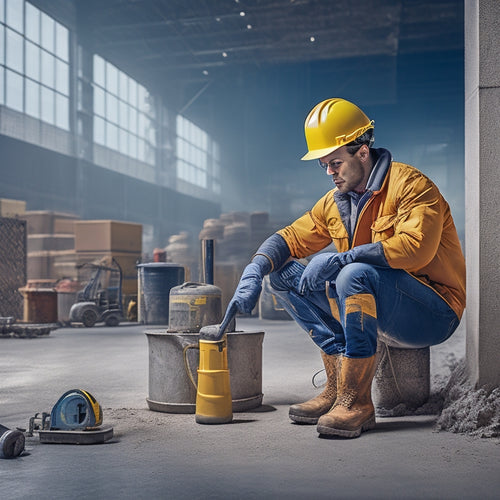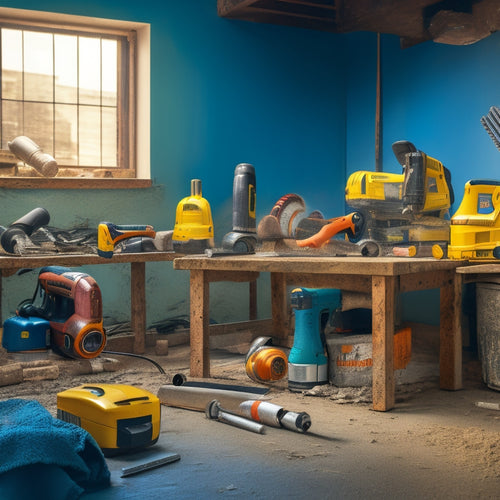
Top 5 Tools for Laying Concrete Blocks Like Pro
Share
You'll need a laser level to project a level line or dot for precise block alignment, a mixing bucket and mixing stick to prepare mortar, a trowel to apply and smooth it, a spirit level to guarantee each block is level and aligned during placement, and a rubber mallet to tap blocks into position. These five essential tools will get you started on laying concrete blocks like a pro. With these in hand, you'll be well on your way to achieving professional results - and with the right techniques and expert guidance, you'll be able to take your skills to the next level.
Key Takeaways
• Use a laser level to project a level line or dot for precise block alignment and ensure a professional finish.
• Invest in a mixing bucket, mixing stick, and mortar mixer drill bit for efficient and consistent mortar mixing.
• Employ a spirit level, leading block, and straightedge to maintain correct alignment and levelness during block laying.
• Choose the right joint-filling tool, such as a jointer tool or V-joint trowel, to achieve the desired joint finish.
• Don't forget essential safety gear, including gloves, safety glasses, steel-toed boots, a dust mask, and knee pads, to protect yourself on the job.
Leveling and Aligning Tools
When laying concrete blocks, you'll need to ascertain a precise foundation, and that starts with using the right leveling and aligning tools to guarantee a straight and even course.
A laser level is an essential tool for this task, as it projects a level line or dot onto the surface, making certain your blocks are aligned perfectly.
Chalk lines are another crucial tool, allowing you to mark straight lines on the surface, which is especially useful when working with large areas or complex patterns.
To maintain accuracy, use a rotary laser level, which provides a 360-degree plane of reference. This will enable you to check the levelness of your surface and make adjustments as needed.
Additionally, consider investing in a self-leveling laser level, which automatically adjusts to the surrounding environment, saving you time and effort.
Mortar Mixing Essentials
Mortar Mixing Essentials
With your blocks accurately aligned and leveled, you're ready to prepare the mortar that will hold them together, and that starts with selecting the right mixing tools and materials. A sturdy mixing bucket, a reliable trowel, and a mixing stick are must-haves for achieving the perfect mortar consistency.
| Mixing Tool | Description | Purpose |
|---|---|---|
| Mixing Bucket | Heavy-duty, rust-resistant bucket | Holds and mixes mortar |
| Mixing Stick | Sturdy, ergonomic handle with mixing blade | Blends and aerates mortar |
| Trowel | Notched or square-edged trowel | Applies and smooths mortar |
| Water Measuring Cup | Accurate, easy-to-read measuring cup | Guarantees correct water-to-mix ratio |
| Mortar Mixer Drill Bit | Heavy-duty drill bit with mixing paddles | Efficiently mixes large quantities |
Mastering mixing techniques is essential for achieving the ideal mortar consistency. Aim for a mix that's workable but not too runny, as this will create a strong bond between the blocks. Remember to mix in small batches, and always follow the manufacturer's instructions for the specific type of mortar you're using. By selecting the right tools and honing your mixing skills, you'll be well on your way to laying concrete blocks like a pro.
Block Laying and Positioning
With your mortar mix ready, you'll need to position the first block, known as the 'leading block,' at the starting point of your wall, ensuring it's perfectly level and aligned with the string line. This initial block sets the tone for the entire wall, so take your time to get it right.
For subsequent blocks, use a spirit level and a straightedge to maintain the correct alignment. When working with different block types, such as solid, hollow, or insulated blocks, adjust your positioning techniques accordingly. For instance, hollow blocks may require additional support or specialized tools.
To achieve precise positioning, use a block-laying trowel to spread a thin layer of mortar on the block's underside, then gently tap it into place using a rubber mallet. As you lay each block, check for levelness, plumbness, and alignment, making adjustments as needed.
Joint Filling and Finishing
You'll now focus on filling the joints between the blocks, a process that requires precision and attention to detail to secure a strong, durable bond. There are several joint types to take into account, including concave, V-joints, and flush joints, each with its own specific requirements and techniques.
For concave joints, you'll need to use a jointer or a specialized trowel to create a curved surface. V-joints, on the other hand, require a V-joint trowel to create a sharp, defined edge. Flush joints, as the name suggests, require a smooth, even finish.
When it comes to finishing techniques, you'll need to decide on the level of finish required for your project. This can range from a basic, rough finish to a highly polished, smooth finish. You may need to use specialized tools, such as a joint finishing tool or a float, to achieve the desired finish.
Regardless of the joint type or finishing technique, it's crucial to follow proper procedures to guarantee a strong, long-lasting bond between the blocks. With the right tools and techniques, you'll be able to achieve professional-looking results that will last for years to come.
Safety and Protection Gear
When laying concrete blocks, you should always prioritize your safety and well-being. At least six essential safety items should be part of your arsenal when laying concrete blocks, including gloves, safety glasses, steel-toed boots, a dust mask, a hard hat, and knee pads.
You may think these items are unnecessary, but trust us, they're vital.
Here are three key reasons why:
-
Protection from falling objects: Hard hats and safety goggles can save you from severe head and eye injuries.
-
Prevention of skin damage: Protective gloves and knee pads can shield your skin from cuts, abrasions, and concrete burns.
-
Breathing safety: A dust mask can prevent inhaling concrete dust, which can cause respiratory problems.
Frequently Asked Questions
Can I Use a Drill to Mix Mortar, or Is a Mixer Necessary?
When it comes to mixing mortar, you're wondering if a drill will suffice or if a dedicated mixer is necessary.
While a drill with a mixing paddle attachment can work, it's not the most efficient option.
You'll struggle to achieve the right mortar consistency, especially with thicker mixes.
For large batches or precise control, a mixer is the way to go.
However, if you're working with small quantities and a specific drill type, like a hammer drill, you might get away with using it.
How Do I Prevent Mortar From Drying Out During Hot Weather?
When working with mortar in hot weather, you'll want to take extra precautions to prevent it from drying out.
You can add mortar additives like retarding agents to slow down the hydration process, giving you more working time.
Implement hydration techniques like keeping the mixing area shaded, using cool water, and covering the mixed mortar with a damp cloth or plastic sheet to minimize evaporation.
What Is the Ideal Temperature for Laying Concrete Blocks?
Are you ready to build a concrete block masterpiece that'll stand the test of time?
When it comes to laying concrete blocks, you'll want to verify the ideal weather conditions. The sweet spot lies between 40°F and 90°F (4°C and 32°C), where the temperature effects on mortar and concrete are minimal.
Avoid extreme temperatures, as they can lead to uneven curing, cracking, or weak bonds. Get it just right, and your blocks will be as solid as a rock!
Can I Lay Concrete Blocks in the Rain or During Freezing Temperatures?
When you're planning to lay concrete blocks, you need to take into account the weather conditions.
It's not recommended to lay blocks in the rain or during freezing temperatures. Water can seep into the mortar, compromising block stability, while freezing temps can cause the mortar to set too slowly or not at all.
You'll end up with weak joints and a structurally unsound wall.
Wait for a dry, moderate-temperature day to guarantee a solid foundation.
How Do I Remove Excess Mortar From Freshly Laid Concrete Blocks?
You'll need to master two essential skills to achieve a professional-looking finish: mortar removal techniques and block finishing methods.
To remove excess mortar from freshly laid concrete blocks, you'll want to act quickly, as it sets fast. Use a soft-bristled brush or a specialized tool to gently sweep away excess mortar, taking care not to scratch the block's surface.
Then, employ a damp cloth or sponge to wipe away any remaining residue, ensuring a smooth finish.
Conclusion
You've built a strong foundation, and now it's time to put the final brick in place.
You've mastered the tools of the trade, and your concrete block wall is standing tall.
Just as a skilled conductor brings harmony to an orchestra, you've orchestrated the perfect blend of leveling, mixing, laying, and finishing.
Your wall is a symphony of strength and precision, a demonstration of your newfound expertise.
With these top 5 tools, you've composed a masterpiece that will stand the test of time.
Related Posts
-

10 Best Tools for Sealed Concrete Flooring on Budget
When starting on a sealed concrete flooring project on a budget, you'll need to prioritize essential tools without sa...
-

Free Design Tools for Concrete House Planning
You can kick-start your concrete house planning project without breaking the bank, as there are several free design t...
-

Essential Power Tools for Concrete Block Construction
When building with concrete blocks, you'll need a range of power tools to cut, drill, mix, and finish the blocks to g...


